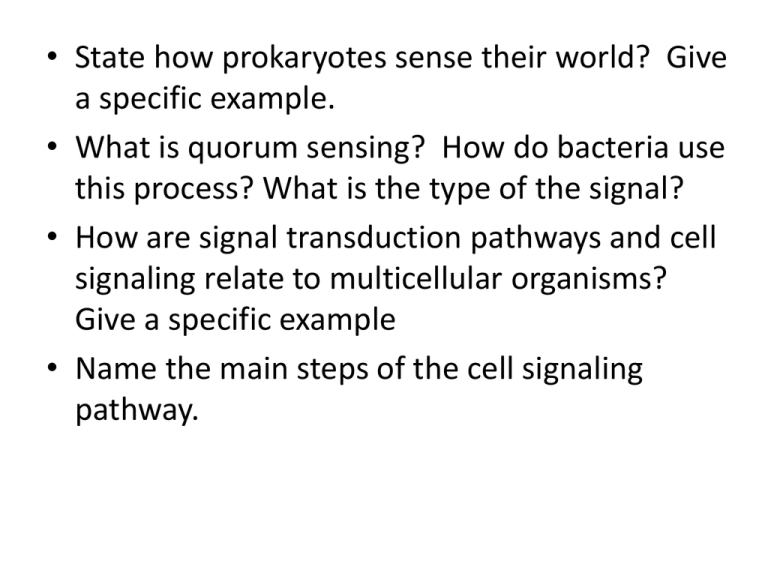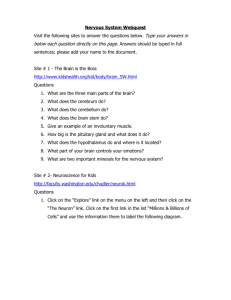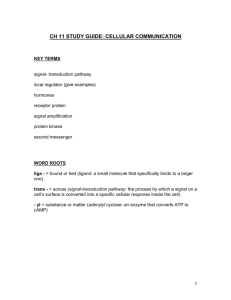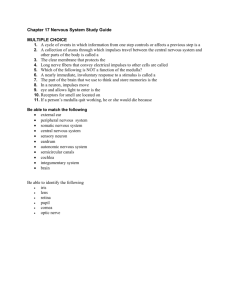Document
advertisement

• State how prokaryotes sense their world? Give a specific example. • What is quorum sensing? How do bacteria use this process? What is the type of the signal? • How are signal transduction pathways and cell signaling relate to multicellular organisms? Give a specific example • Name the main steps of the cell signaling pathway. • The picture below represents part of an experiment on quorum sensing. Predict the outcome of the experiment and justify your answer. • What type of signal is used when – the pancreas beta cells release glucagon and it activates liver cells to release glucose – A yeast cell initiates a nearby cell to fuse for sexual reproduction • Name the two basic types of receptors and their location. • How can a small, nonpolar signal molecule directly activate a gene? • What does it indicate that most organisms have similar structured intracellular receptors? Identify the receptor and determine its type of the following cell signaling pathways: • How can a target cell’s response to a single signal molecule result in a response that affects a million other molecules? • Compare the structure and function of receptor tyrosine kinases and G protein-linked receptors. • Humans have the ability to recognize many different aromatic chemicals by smell even in very small concentrations. For example, the majority of humans can detect chlorine at a concentration of about 0.3 ppm (0.3 molecules in one million other molecules). – What characteristics of the olfactory cells would you look for to explain this? – Dogs are known to have a much better sense of smell than humans. Given this, what differences may exist in their olfactory system as compared to humans? • What are hormones? • What is the difference between endocrine and neurosecretory signals? • What are pheromones? How are they used for animal communication? What type of communication are they used for? • Differentiate between the release and transport of a water soluble and fat soluble hormone. • Differentiate between the action of a water soluble and fat soluble hormone on the target cell. • Describe how the body responds to a stressor. • Describe the hormonal mechanism that results in stress response. • Describe the nervous mechanism that results in stress response. • Describe the hormone pathway for one specific negative feedback mechanism. • Describe the hormone pathway for one specific positive feedback mechanism. • Name the structure of one specific hormone, the type of receptor, transduction pathway and response that it generates in the target cell. • Draw and label the parts of a neuron. • Name two types of glial cells and describe their general function. • Describe three types of neurons. • How can a hormone have different responses in different cells? • List three evolutionary trends of nervous system formation in animals. Describe each • List the types of ions and their locations that participate in forming the resting potential. • List and describe the functions of various transport proteins that participate in forming membrane potential in neurons. • Why is the resting potential negative inside the neuron? • Why doesn’t action potential and depolarization mean the same thing? • What is a threshold? • How might increased branching of the axon help coordinate responses to signals by the nervous system? • Suppose a cell’s membrane potential shifts from -70mV to -50mV. What changes in the cell’s permeability of K and Na ions can cause such a shift? • Suppose a mutation caused gated sodium ion channels to remain inactivated longer after an action potential. How would this affect the frequency at which action potentials could be generated? Explain. • Some nerve gases and insect poisons work by destroying acetylcholine esterase. This enzyme normally present in acetylcholine synapses and acts to degrade acetylcholine. What is likely to happen to nervous transmission in organisms that are exposed to this kind of poison? • Tetrodotoxin in pufferfish block the Na+ ion channels in neurons. What specific effects could this toxin have on neuron function? • Name two factors that can determine if an action potential is generated on the postsynaptic membrane. • How does the central nervous system differ from the peripheral nervous system in structure and function? • Name the two subdivisions of the peripheral nervous system. Describe the function of each. • Name the subdivisions of the autonomic nervous system and describe their functions.









